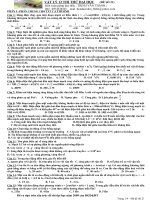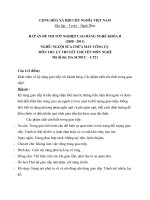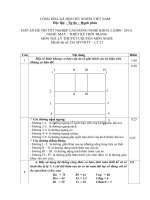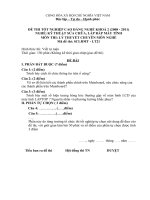PASSAGE 21
Bạn đang xem bản rút gọn của tài liệu. Xem và tải ngay bản đầy đủ của tài liệu tại đây (50.12 KB, 3 trang )
PASSAGE 21
Let’s see if you can correctly answer the following question: At what aue are Latter-day Saint youth
allowed to date? Of course, you probably immediately said, “16”. OK, then, how about this one: At what
age are you allowed to have a boyfriend or girlfriend? You may be thinking, “Um, 16. Didn’t I just
answer that?” Well, if that vvas your answer, then, even though you aced the first question, you missed
the second one. Just because you can datc when you turn 16 doesn’t mean you should immcdiately start
looking for a steady boyfriend or girlfriend.
For decades, prophets have preached that youth who are in no position to marry should not pair off
exclusively. For instance, President Hinckley (1910-2008) said, “When you are young, do not gct
involved in steady dating. When you reach an age where you think of marriage, then is the time to
become so involved. But you boys who are in high school don’t need this, and neither do the girls”. So
what does this counsel really mean, and what are the reasons for it?
To begin with, there are two different types of dating: casual dating and steady (or serious) dating. The
distinction between the two has to do with exclusivity. With casual dating, there is no exclusivity. The two
people aren’t “a couple” or “an item”, and they don’t refer to each other as a “boyfriend” or “girlfriend”.
They don’t pair off. People who are casually dating are simply friends. This is the kind of dating the
Church encourages you to do after you turn 16. You should put aside a need to find a “one and only”. If
you’re dating casually, you don’t expect a relationship to become a romance. You have fun; you do a
variety of things with a variety of people. On the other hand, steady dating means the couple is exclusive
with one another. They expect each other not to date anyone else or to be emotionally or physically close
with other people. Couples who date seriously consider the future, because there is a real possibility they
could stay together. This is the kind of dating the Church encourages young adults (generally, people in
their 20s) to progress toward, because that’s the age when they should be thinking of marrying.
You should avoid becoming exclusive as teenagers, because an exclusive relationship requires a high
level of commitment from both partners, and you’re not in a position to make that kind of commitment as
teens – neither emotionally, physically, nor in terms of your future plans. As President Boyd K. Packer,
President of the Quorum of the Twelve Apostles, has, said to youth, “Avoid steady dating. Steady dating
is courtship, and surely the beginning of courtship ought to be delayed until you have emerged from your
teens”.
Source:
Question 1. It can be inferred from the fírst paragraph that ________ .
A. Dating doesn’t mean having exclusive boyfriend or girlfriend
B. Teenagers are supposed to have a steady boyfriend or girlfriend
C. Teenagers date as many boyfriends or girlfriends as they can
D. Young people shouldn’t be allowed to date at 16
Question 2. The word “aced” in paragraph 1 is closest in meaning to _________ .
A. Gave up
B. misled
C. succeeded in
D. understood
Question 3. According to the passage, what is NOT true about casual dating?
A. You can be íriend with each other.
B. You don’t pair off exclusively.
C. You find your “one and only”.
D. You meet different kinds of people.
Question 4. It is stated in the passage that steady dating ________.
A. Includes a variety of things with a variety of people
Page 1
B. Is courtship that you ought to have in your teens
C. Requires hardly any commitment
D. Suits people who are in their 20s
Question 5. Which of the following would serve as the best title for the passage?
A. At what age are young people allowed to date?
B. Casual dating or steady dating.
C. Malce your teenage dating by keeping it casual.
D. Popular kinds of dating for teenagers.
ĐÁP ÁN
1-A
2-C
3-C
4-D
5-C
LỜI GIẢI CHI TIẾT
Question 1:
Nó có thể được suy ra từ đoạn đầu tiên là ____.
A. Hẹn hị khơng có nghĩa là chỉ có duy nhất bạn trai hay bạn gái
B. Thanh thiếu niên được cho là sẽ có bạn trai hoặc bạn gái ổn định
C. Thanh thiếu niên có thể hẹn hị với nhiều bạn trai hoặc bạn gái
D. Những người trẻ tuổi không nên được phép hẹn hò ở tuổi 16
=> Dẫn chứng: Just because you can datc when you turn 16 doesn’t mean you should immcdiately start
looking for a steady boyfriend or girlfriend.
Chỉ vì bạn có thể hẹn hị khi bạn 16 tuổi khơng có nghĩa là bạn nên bắt đầu tìm kiếm một người bạn trai
hay bạn gái ổn định.
Question 2:
Từ "aced" trong đoạn 1 có nghĩa gần nhất với _________.
A. bỏ
B. lỡ
C. thành công
D. hiểu
=> Dẫn chứng: Well, if that was your answer, then, even though you aced the first question, you missed
the second one.
Dịch: Chà, nếu đó là câu trả lời của bạn, thì, mặc dù bạn đã trả lời câu hỏi đầu tiên, bạn đã bỏ lỡ câu hỏi
thứ hai.
Question 3:
Theo đoạn văn, điều gì KHƠNG đúng với việc hẹn hị thơng thường?
A. Bạn có thể là bạn với nhau.
B. Bạn don cặp đơi độc quyền.
C. Bạn tìm thấy một trong những người duy nhất của bạn.
D. Bạn gặp nhiều loại người khác nhau.
=> Dẫn chứng: With casual dating, there is no exclusivity. The two people aren’t “a couple” or “an item”,
and they don’t refer to each other as a “boyfriend” or “girlfriend”. They don’t pair off. People who are
casually dating are simply friends.
Page 2
Dịch: Với hẹn hị thơng thường, khơng có độc quyền. Hai người có một cuộc hẹn hị với nhau và một
người khác, và họ không thể gọi nhau là bạn trai hoặc bạn gái. Họ không cặp đôi. Những người tình cờ
hẹn hị chỉ đơn giản là bạn bè.
Question 4:
Nó được nêu trong đoạn văn có cuộc hẹn hị ổn định ____.
A. Bao gồm nhiều thứ với nhiều người
B. Là sự tán tỉnh mà bạn nên có ở tuổi thiếu niên
C. u cầu hầu như khơng có cam kết
D. Phù hợp với những người ở độ tuổi 20
=> Couples who date seriously consider the future, because there is a real possibility they could stay
together. This is the kind of dating the Church encourages young adults (generally, people in their 20s) to
progress toward, because that’s the age when they should be thinking of marrying.
Các cặp đơi hẹn hị nghiêm túc xem xét tương lai, bởi vì có khả năng thực sự họ có thể ở bên nhau. Đây là
kiểu hẹn hị mà Giáo hội khuyến khích những người trẻ tuổi (nói chung, những người ở độ tuổi 20) tiến
tới, bởi vì đó là tuổi khi họ nên nghĩ đến việc kết hôn.
Question 5:
Điều nào sau đây sẽ là tiêu đề tốt nhất cho đoạn văn?
A. Ở độ tuổi nào, những người trẻ tuổi được phép hẹn hị?
B. Hẹn hị bình thường hoặc hẹn hò ổn định.
C. Malce hẹn hò tuổi teen của bạn bằng cách giữ cho nó bình thường.
D. Các loại hẹn hò phổ biến cho thanh thiếu niên.
=> Dẫn chứng: You should avoid becoming exclusive as teenagers, because an exclusive relationship
requires a high level of commitment from both partners, and you’re not in a position to make that kind of
commitment as teens – neither emotionally, physically, nor in terms of your future plans
Dịch: Bạn nên tránh trở thành độc quyền khi cịn là thanh thiếu niên, bởi vì mối quan hệ độc quyền đòi
hỏi mức độ cam kết cao từ cả hai bên và bạn khơng có khả năng thực hiện cam kết đó khi cịn là thanh
thiếu niên - không phải về mặt cảm xúc, thể chất cũng như tương lai các kế hoạch
Page 3









